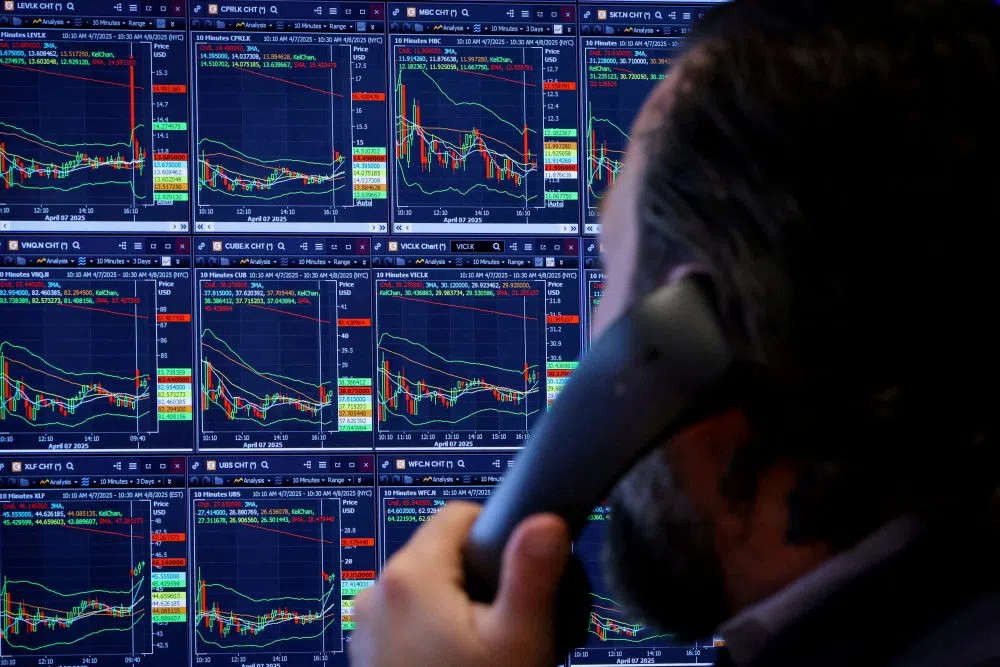(Reuters) – The S&P 500 soared 9.5% on Wednesday for its biggest daily gain since 2008 after U.S. President Donald Trump declared an immediate 90-day tariff pause for many countries, bringing some relief to investors worried about the global economic impact of U.S. trade policies.
The rally, which followed Wall Street’s biggest four-day percentage loss since the pandemic, was triggered by an afternoon announcement that Trump would temporarily lower many new tariffs, while he raised the levy on Chinese imports to 125%.
The pause of heftier tariffs on dozens of countries came less than 24 hours after they kicked in. However, the White House kept a 10% blanket duty on almost all U.S. imports.
The increase in China tariffs was in retaliation for China’s announcement of an 84% levy on U.S. goods starting April 10.
Traders took the opportunity to shop for beaten-down stocks. Since Trump announced broad tariffs late on April 2, stocks had fallen more than 12%.
“This is the pivotal moment we’ve been waiting for. The immediate market reaction has been overwhelmingly positive, as investors interpret this as a step toward much-needed clarity,” said Gina Bolvin, president of Bolvin Wealth Management Group.
“However, uncertainty looms over what happens after the 90-day period, leaving investors to grapple with potential volatility ahead.”
After Trump’s pause announcement, Goldman Sachs said it was rescinding its recession forecast and reverting to its previous baseline estimate for the economy to grow in 2025.
Kevin Gordon, senior investment strategist at Charles Schwab, said the rally from oversold levels made sense but cautioned that “to have a high conviction call on anything right now is a fool’s errand.”
“We just have to wait and see what the ultimate policy is, but unfortunately the policy changes almost on a daily basis,” said Gordon, adding he was concerned about companies’ ability to make spending and hiring decisions in such an environment.
Even with the rally, all three of Wall Street’s major averages ended the session below the April 2 close, the last trading day before Trump unveiled broad tariffs.
The Dow Jones Industrial Average rose 2,962.86 points, or 7.87%, to 40,608.45.
The S&P 500 gained 474.13 points, or 9.52%, to 5,456.90 for its biggest daily gain since October 2008, during the global financial crisis.
The Nasdaq Composite added 1,857.06 points, or 12.16%, to 17,124.97, for its biggest gain since January 2001, during the dotcom market bubble.
The smallcap Russell 2000 Index added 8.66%, for its biggest one-day jump since March 2020.
All 11 of the S&P 500’s major industry indexes finished higher, with technology adding 14.15%. Defensive utilities were the slowest gainer, adding 3.91%.
Large technology stocks provided the biggest boost, with Nvidia adding 18.7% and Apple rising 15.3%.
The S&P 500 Auto Index ended up 20.95%, by far its biggest daily gain on record.
Also helping to calm investor sentiment was the U.S. Treasury’s $39-billion 10-year note auction. The auction came within market expectations, priced at a high yield of 4.435%, lower than the rate forecast at the bid deadline, suggesting solid investor demand. [US/]
“Longer-term questions will almost certainly remain. But this afternoon’s announcement, combined with the Treasury auction, is a welcome relief after several days of very high volatility,” said Jeffrey Palma, head of multi-asset solutions and macro research at Cohen & Steers in New York.
The CBOE Volatility Index – seen as Wall Street’s “fear gauge” – fell sharply after the tariff pause to end the day at 33.62 points, compared with its session high of 57.96.
Minutes from the Federal Reserve’s meeting last month were also released in the afternoon.
Fed policymakers were nearly unanimous that the U.S. economy faced risks of simultaneously higher inflation and slower growth, with some policymakers noting that “difficult tradeoffs” could lie ahead for the central bank.
A consumer price inflation report scheduled for Thursday morning will be closely watched by investors for clues on the inflation trajectory.
The upcoming earnings season will offer more insights into the health of corporate America as investors fear a hit to economic growth from the tariffs. U.S. banks, including JPMorgan Chase, will report first-quarter results on Friday.
Delta Air Lines shares soared 23.4% after the carrier beat first-quarter profit expectations. The company, though, pulled its 2025 financial forecast and projected current-quarter profit below expectations.
Advancing issues outnumbered decliners by a 6.4-to-1 ratio on the NYSE where there were 30 new highs and 1,187 new lows.
On the Nasdaq, 3,841 stocks rose and 684 fell as advancing issues outnumbered decliners by a 5.62-to-1 ratio. The S&P 500 posted one new 52-week high and 100 new lows while the Nasdaq Composite recorded 12 new highs and 646 new lows.
Wednesday was a record day for trading volume with 30.5 billion shares changing hands on U.S. exchanges, compared with the 18.06 billion average for the last 20 sessions.
(Reporting by Sinéad Carew, Saeed Azhar, Chuck Mikolajczak and Carolina Mandl in New York; Shashwat Chauhan and Purvi Agarwal in Bengaluru; Additional reporting by Pranav Kashyap; Editing by Arun Koyyur, Maju Samuel and Rod Nickel)




Comments